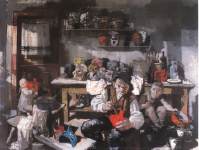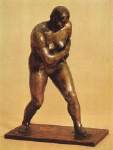

Hungarian art in the first half of the twentieth-century can be classed among two great periods. The first embraces the period of the turn of the century, included the last decade of the 19th and the first two decades of the twenties century, from the millenium years to the end of World War I. The second is the interwar period, the two-and-a-half decades between World War I and II.
The Transylvanian born István Nagy began his career around the turn of the century and painted his most characteristic pastels in the twenties and thirties: Snowy Landscape (c. 1930), Hillside with Poplars (1927), Peasant Girl with Jug (c. 1927), Schoolboy, (c. 1932). These geometrically structured compositions reflect a further constructivist tendency.
At the end of the twenties more and more artists won the scholarships of the Hungarian Academy in Rome and influenced by the Italian Neoclassicism created a monumental painting and sculpture, which became the official art in the thirties. In spite of this many of the artists, having spent a longer time in Italy, were never touched by Neoclassicism and some, like István Szőnyi, worked in this neoclassicist style only in a certain stage of their artistic development. One of the most talented masters of the style known as Roman School was Vilmos Aba-Novák. Besides his monumental frescoes from the thirties we appreciate his pictures showing markets, travelling circuses, cook's stalls with subtle irony.
The expressive pictorial language of the interwar period originated in different inspirations. Only an increased sensibility and a forceful formation that interlinked the different manifestations of the style. In his late period János Vaszary created an individual style of virtuosity. His paintings reflected a modernizing urban life in the twenties and thirties. Though Róbert Berény never denied his previous subjective-expressionist attitude, created as a member of The Eight later on, after his exile in Berlin, his pictorial expression completely changed. Turning back to the traditions of Nagybánya he painted his low-keyed masterpieces, of velvety effect; Woman Playing the Cello (1928), Pecking Chicken (1933). After an avantgarde period the painting of Ödön Márffy became the interpreter of his subjective feelings and moods in accordance with the taste of Paris School. István Farkas's deformed persons and landscapes of his dreamworld reflect his tragical attitude to life.
Aurél Bernáth and István Szőnyi, the prominent representatives of the Post-Nagybánya movement, created their individual styles in the early twenties. In every stage of their career they considered the conception of Nagybánya Artist's Colony fundamental. The expressionist tendencies of the period culminated in the works of József Egry and Gyula Derkovits. Egry was closely attached to the artists of Gresham Group, the foundation members of the school of Post-Nagybánya. Since 1918 he was working at Lake Balaton and inspired by the landscape he created a brilliant subjective pictorial expression. Gyula Derkovits was one of the most prominent figures not only of the expressionist trend but the whole modern Hungarian art, as well. He showed great concern about worker's life. He used modern pictorial means like montage composition, combination of different view-points, formal and conceptual concentration. With some of his early works and the masterpieces of his mature expressive period - For Bread (1930), The Verdict (1930), Three Generations (1932), Along the Railway (1932), Bridge in Winter (1933) give a tinged picture of his artistic development. Derkovits's style is a unique one without any direct follower. Still, his revolutionary ideas, worker- and peasant types of his figurative compositions may bring István Dési Huber nearer to Derkovits.
Parallel with several trends in painting the representatives of sculpture were progressing along a similar path. The principal works of Ferenc Medgyessy from this period: Dancer (1932), Leaning Woman (1923) (female nude), Turanian Rider (1930), Seed Sower (1930). The art of Pál Pátzay and Béni Ferenczy can be linked to the conception of Post-Nagybánya group. Pál Pátzay, a leading figure of Gresham Group was an influental artist and interested in theoretical questions, too. In his sculpture he mixed the neoclassic traditions with a new sensibility. Though Béni Ferenczy turned back to a more ancient source, the antiquity, he was highly responsive to the revolutionary change of modern plastic art, especially by the activities of French masters Maillol and Despiau. The expressive plastic style of Dezső Bokros Birman, based on classical traditions, was embodied in his small bronze statues with deforming gestures and strongly marked features.
The art of László Mészáros, considering its origin, intellectual content and aesthetic quality, is comparable to the oeuvre of Derkovits. His chef d'oeuvre is The Prodigal Son (1930). The short-lived György Goldman, a talented sculptor, left behind a rich oeuvre. His Seated Workman (1934) became a symbol of labour movement.
The Szentendre Artist's Colony, founded in 1928, was the very scene of a new avantgarde development of modern Hungarian painting in the thirties. Its character was determined by three main sylistic trends, though never appeared in a chemically pure form. Béla Czóbel, touched by the Expressionism of Paris School painted his vivid, colourful pictures at that time (Young Girl with Ribbon, c. 1930; Still Life with Jug, 1934). Jenő Barcsay created his constructive pictorial expression by transforming the well-known motives of Szentendre into abstract elements of his compositions. (Hilly Landscape, 1934).
Lajos Vajda and Dezső Korniss were the creators of the Hungarían variety of Surrealism. Refering to the ideas of Kodály and Bartók they put into words their program:"... Without tradition nothing can be done; and this in Hungary can be only the Hungarian folk art. We want the same as Bartók and Kodály have done in music ...". In accordance with their principles they turned to the local traditions of Hungarian and Serbian religious- and folk art. Two pictures of Vajda, inspired by icon painting: Self-Portrait with Lily (1936), and Icon with Mask (1936) as well as Korniss' Motif of Szentendre (1935) illustrate their conception. Jenő Paizs Goebel, worked in Szentendre since the early thirties, mixed naive and magic elements in his surrealist painting. Following Chagall's visionary painting Imre Ámos protested against the horrors of war with his paintings, of tragic tone (Burning Synagogue, 1938); Dark Times, 1940); Self Portrait on Catafalque, 1943).